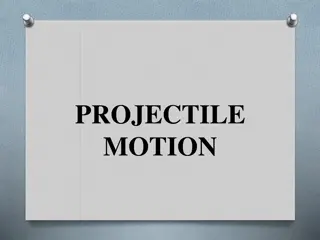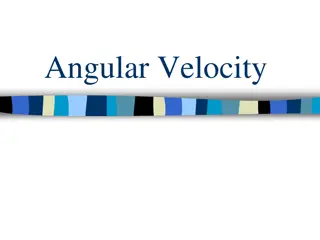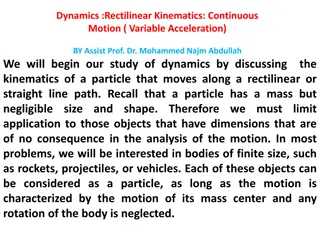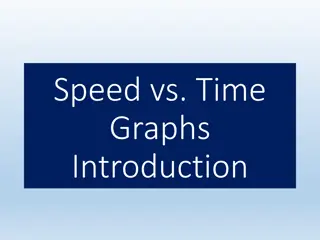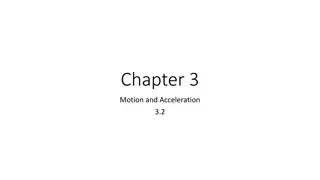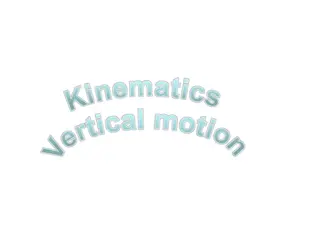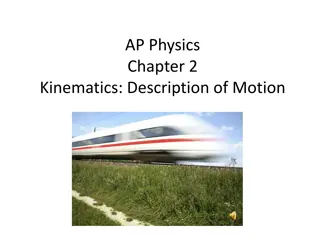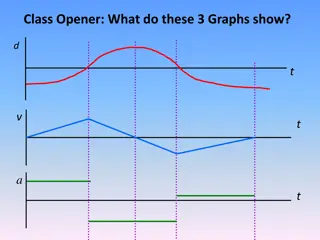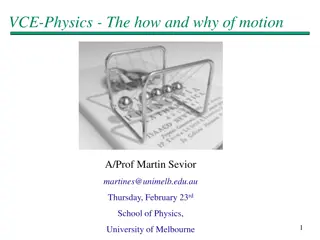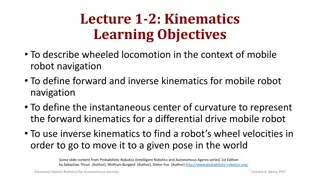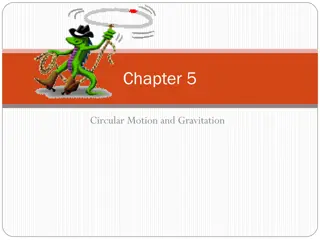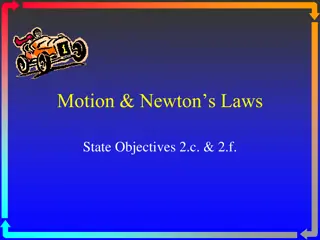Dynamics: Rectilinear Kinematics - Continuous Motion with Variable Acceleration
Begin your study of dynamics by understanding the kinematics of a particle moving along a straight path. Learn about position, velocity, acceleration, displacement, and how to differentiate between them. Explore the concept of speed and average speed as essential components of rectilinear motion.
Download Presentation

Please find below an Image/Link to download the presentation.
The content on the website is provided AS IS for your information and personal use only. It may not be sold, licensed, or shared on other websites without obtaining consent from the author.If you encounter any issues during the download, it is possible that the publisher has removed the file from their server.
You are allowed to download the files provided on this website for personal or commercial use, subject to the condition that they are used lawfully. All files are the property of their respective owners.
The content on the website is provided AS IS for your information and personal use only. It may not be sold, licensed, or shared on other websites without obtaining consent from the author.
E N D
Presentation Transcript
Dynamics :Rectilinear Kinematics: Continuous Motion ( Variable Acceleration) BY Assist Prof. Dr. Mohammed Najm Abdullah We will begin our study of dynamics by discussing kinematics of a particle that moves along a rectilinear or straight line path. Recall that a particle has a mass but negligible size and shape. Therefore we must limit application to those objects that have dimensions that are of no consequence in the analysis of the motion. In most problems, we will be interested in bodies of finite size, such as rockets, projectiles, or vehicles. Each of these objects can be considered as a particle, as long as the motion is characterized by the motion of its mass center and any rotation of the body is neglected. the
Rectilinear Kinematics. The kinematics of a particle is characterized by specifying, at any given instant, the particle's position, velocity, and acceleration. Position. The straight-line path of a particle will be defined using a single coordinate axis see Fig. 1a. The origin 0 on the path is a fixed point, and from this point the position coordinate (S) is used to specify the location of the particle at any given instant. The magnitude of (S) is the distance from 0 to the particle, usually measured in meters (m) or feet (ft), and the sense of direction is defined by the algebraic sign on (S). Although the choice is arbitrary, in this case s is positive since the coordinate axis is positive to the right of the origin. Likewise, it is negative if the particle is located to the left of O. Realize that position is a vector quantity since it has both magnitude and direction. Here, however, it is being represented by the algebraic scalar s since the direction always remains along the coordinate axis. Displacement. The displacement of the particle is defined
Displacement. The displacement of the particle is defined as the change in its position. For example, if the particle moves from one point to another, Fig. 1b, the displacement is ? = ? ? In this case ? is positive since the particle's final position is to the right of its initial position, i.e., ? > S. Likewise, if the final position were to the left of its initial position, ? would be negative. The displacement of a particle is also a vector quantity, and it should be distinguished from the distance the particle travels. Specifically, the distance traveled is a positive scalar that represents the total length of path over which the particle travels. Velocity. If the particle moves through a displacement ? during the time interval ? , the average velocity of the particle during this time interval is ?avg= ? ?
If we take smaller and smaller values of ? , the magnitude of ? becomes smaller and smaller. Consequently, the instantaneous velocity is a vector defined as, ? = lim ? 0 ? / ? , or --------- 1 Since ? or dt is always positive, the sign used to define the sense of the velocity is the same as that of ? or ds. For example, if the particle is moving to the right, Fig. 1c, the velocity is positive; whereas if it is moving to the left, the velocity is negative. (This is emphasized here by the arrow written at the left of Eq. 1.) The magnitude of the velocity is known as the speed, and it is generally expressed in units of m/s or ft/s. Occasionally, the term "average speed" is used. The average speed is always a positive scalar and is defined as the total distance traveled by a particle, ST, divided by the elapsed time ?: i.e.,
Acceleration. Provided the velocity of the particle is known at two points, the average acceleration of the particle during the time interval ? is defined as Here represents the difference in the velocity during the time interval t, i.e., = v' - v, Fig. 1d. The instantaneous acceleration at time t is a vector that is found by taking smaller and smaller values of t and corresponding smaller and smaller values of , so that a = lim ? 0 / ? , or --------- 2 Substituting Eq. 1 into this result, we can also write
Both the average and instantaneous acceleration can be either positive or negative. In particular, when the particle is slowing down, or its speed is decreasing, the particle is said to be decelerating. In this case, v' in Fig. 1e is less than v, and so = v' - v will be negative. Consequently, a will also be negative, and therefore it will act to the left, in the opposite sense to v. Also, note that when the velocity is constant, the acceleration is zero since = v - v = 0. Units commonly used to express the magnitude of acceleration are m/s2or ft/s2. Finally, an important differential relation involving the displacement, velocity, and acceleration along the path may be obtained by eliminating the time differential dt between Eqs. 1 and 2, which gives a ds = v dv --------- 3 Although we have now produced three important kinematic equations, realize that the above equation is not independent of Eqs. 1 and 2.
Important Points Dynamics is concerned with bodies that have accelerated motion. Kinematics is a study of the geometry of the motion. Kinetics is a study of the forces that cause the motion. Rectilinear kinematics refers to straight-line motion. Speed refers to the magnitude of velocity. Average speed is the total distance traveled divided by the total time. This is different from the average velocity, which is the displacement divided by the time. A particle that is slowing down is decelerating. A particle can have an acceleration and yet have zero velocity. The relationship a ds = v dv is derived from a = dv/dt and v = ds/dt, by eliminating dt
Important Rules If s = f(t) s = 2t2+ 4t + 10 ?? ??= 4? + 4 ? =?? ??= 4 ? = If a = f(t) ? = 2? + 7 ? ? 2? + 7 ?? ? ?0= ?2+ 7? ?? = ??? ?? = ?0 0 ? = ?0+ ?2+ 7? ? ?? = ? ?0+ ?2+ 7? ?? ?? = ??? ?0 0 ? ?0= ?0? +1 ? = ?0+ ?0? +1 3?3+7 3?3+7 2?2 2?2
Procedure for Analysis Coordinate System. Establish a position coordinate s along the path and specify its fixed origin and positive direction. Since motion is along a straight line, the vector quantities position, velocity, and acceleration can be represented as algebraic scalars. For analytical work the sense of s, v, and a is then defined by their algebraic signs. The positive sense for each of these scalars can be indicated by an arrow shown alongside each kinematic equation as it is applied. Kinematic Equations. If a relation is known between any two of the four variables a, v, sand t, then a third variable can be obtained by using one of the kinematic equations, a = dv/ dt, v = ds/ dt or a ds = v dv, since each equation relates all three variables. Whenever integration is performed, it is important that the position and velocity be known at a given instant in order to evaluate either the constant of integration if an indefinite integral is used, or the limits of integration if a definite integral is used.
Example 1: A car moves in a straight line such that for a short time its velocity is defined by v = (3t2+ 2t) ft/s, where t is in seconds. Determine its position and acceleration when t = 3 s. When t = 0, S=0 SO LUTI O N Coordinate System. The position coordinate extends from the fixed origin O to the car, positive to the right. Position. Since v = f(t), the car's position can be determined from v = ds/ dt, since this equation relates v, s, and t. Noting that s = 0 when t = 0, we have v = ds / dt = (3t2+ 2t) ? ?? = 0 S =t3+t2 s = (3)3+ (3)2= 36 ft ? 3?2+ 2? ?? 0 o S s= 36 ft Acceleration. Since v = f(t), the acceleration is determined from a = dv/dt, since this equation relates a, v, and t. a=?? ? ??3?2+ 2? = 6? + 2 ??= a = 6(3) + 2 = 20 ( ft/S2) When t = 3 s,
Example 2: A metallic particle subjected to the influence of a magnetic field as it travels dowmward through a fluid that extends from plate A to plate B. as shown in Fig. If the particle is released from rest at midpoint C, S= 100 mm and the acceleration is a-= (4S) m/s2. where S is in meters. Determine the velocity of the particle when it reaches plate B, S=200 mm, and the time it takes to travel from C to B



